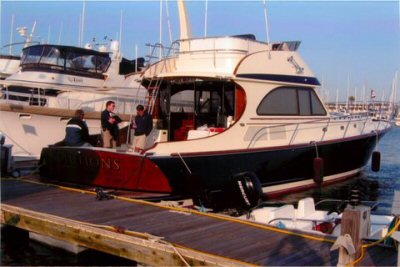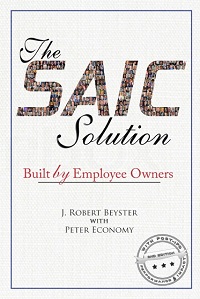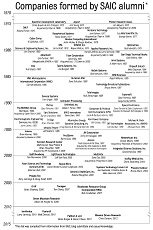Biofuels Forum and Come Sail with Me
10 Comments Published by Dr. Beyster April 11th, 2009 in San Diego, Technology.Last week was a busy one for me. The most intellectually stimulating thing that occurred was a forum I attended on algae-based biofuels sponsored by Scripps Institute of Oceanography, where we met with all the senior scientists working on the problem. About three different approaches are currently being pursued to see what works best. I noticed that all of the approaches would involve the use of large ponds where the algae and sunlight would together produce the fuel. This is in contrast to the Venter approach which I believe is done in large vats. I’m curious to know whether any of the readers of this blog have an informed opinion on which approach might work best. This information may not be available for a couple of years, until they get out of the lab and into the field and are able to assess the relative efficiencies of each method.
A suggestion was recently made by Ron Arnold, who is in charge of placing content on the SAIC website. He also happens to be the skipper of my boat Solutions. The suggestion is to have a periodic drawing of all the people who post on the blog. We will draw a name, and whoever’s name is drawn will be invited to join me for an excursion on Solutions, including lunch at either the Jolly Roger in Oceanside Harbor or the Loews Coronado Bay Resort, depending on which way we go. Seasickness is forbidden, and you’ll need to provide your own transportation to the boat dock in San Diego Bay. A picture of the boat is included here to indicate that it is not a rowboat.

– Bob





That’s a great idea – I wish I lived anywhere close to San Diego, it would be a great opportunity to cruise around with you, but I don’t think I could get myself out to San Diego.
As for the algae biofuels, I’m sure you are aware of the DARPA contract SAIC won recently. I’ve been trying to stay up on the details but can never seem to have time to really focus on it. I think it is a promising possibility – it just needs to become more feasible on a very large scale. It’ll be an interesting industry to watch regardless.
I don’t know much about this but i did see a “production” plan for Venice. See http://green.yahoo.com/blog/ecogeek/1023/venice-to-use-algae-for-50-of-its-electricity.html.
Probably everyone has seen this but it “sounded” advance.
John: Thank you for pointing out the article on Venice’s algae-based biofuel project. As you know, I’m a big believer in this technology, and I will follow Venice’s progress with interest. I’m still curious if growing the algae in ponds or vats is better. My preference is to grow it in vats because I think the success of the pond approach depends on too many environmental variables being right. These variables include the amount of available sunlight, the effects of wind, dust, and evaporation, and possible contamination from other organisms. I’m wondering if you have an idea what the optimum way is to produce the algae. — Bob
CGordon: Thank you for responding to my last blog post. We are fully aware of the SAIC contract to develop biofuels and agree that this method of generating energy needs to be explored vigorously across the country. There is still much work to be done, including determining the optimum way to grow the algae. There is a gap between our ability to develop the proper procedure and reducing it to practice on a large-scale basis. I suspect it’s a few years off. — Bob
Dr. Beyster,
This question is like asking about religion, a lot of the answer is based on faith, not fact. The problem with closed bioreactors (vats) is the capital expense to build them. The problem with open ponds, as you point out, is control. I would say that for some things where the cost of goods will sustain it, closed bioreactors will work just fine, and I use them for making protein therapeutics in algae, and would not consider open ponds for this purpose. If we are going to make biofuel though, that is a different story. Fuel, even at $4 gallon is still only $0.60 a pound, and it’s tough to get that cost of goods out of a facility that contains expense bioreactors. If that is going to work you better make an algae that really put out the fuel, and it better float to the top, as the Venter plan imagines. For those of us that think about fuels retained inteh algae, then open ponds are the only way cheap enough to work. As for control of open ponds, we manage to make it work with corn, rice, and wheat in the field, so I think we can do it for algae, but there is some work still to be done there.
Finally, does that nice looking boat of yours ever go out after tuna?
Steve
Steve: You can’t imagine how pleased I am to receive your posting. I’m very excited to hear about this, and I wish there was more I could do to help. I guess both routes — closed bioreactors and open ponds — will be examined for a while. We should soon know which is producing more efficiently. I’m wondering if you are working on this quest for a biofuel alternative to petroleum. Please keep me informed. I don’t know what kind of boatsman you are, but if you’d like to go out on my boat one Friday I’d like you to join me. We’re not yet equipped for fishing — we focus on trips to Oceanside, Coronado, and sometimes Catalina. — Bob
Dr Beyster
You may have seen this in the news
Here is a short video about algae bio fuels
http://cosmos.bcst.yahoo.com/up/player/popup/?rn=3906861&cl=13177154&ch=4226724&src=news
- Stephen
Steve: Thank you very much for the video — I’ll have a look. — Bob
Dr. Beyster,
I am an SAIC alum from the 80′s, worked with Blake Putney and the folks in the Los Altos, CA office. I have fond memories of SAIC’s involvement in the Americas Cup in those days. Today I am a co-founder of A2BE Carbon Capture, we use the brand Algae@Work. Our principal technical work is in closed photobioreactors (PBR) for the cultivation of algae on an industrial scale. Beyond algae for biofuels, a number of policy makers and electric utilities are interested in closed PBR systems and product outcomes that capture, recycle, and sequester CO2 from stationary emission sources. Yes, it is possible to monetize pollution into some very interesting products. You will find a lot of information at our website http://www.algaeatwork.com. You may also be interested the Algal Biomass Organization (ABO) http://www.algalbiomass.org . I am a founding board member of ABO, corporate members include Boeing, Raytheon, General Atomics, EPRI, UOP, and many others that are working to commercialize algae based products including jet fuel and even rocket fuel. The third annual Algae Biomass Summit will be held this October in San Diego. This is a by invitation event for about 1000 scientists, engineers, VC’s, and industry executives; if you are interested I can make sure you get invited.
Best regards and enjoy your adventures on Solutions,
Mark
Mark: I am very interested in the algae research you are doing, and would like invitations for my daughter Mary Ann Beyster and me to attend the Algae Biomass Summit here in San Diego in October. Thank you. — Bob